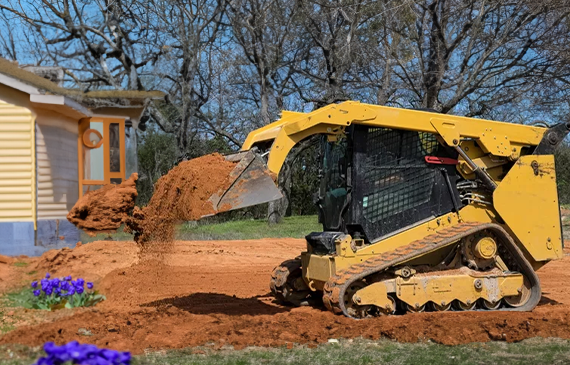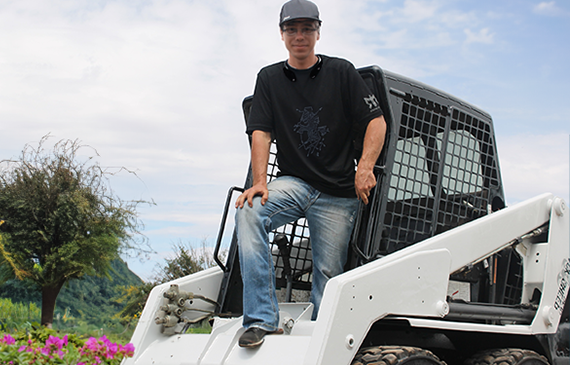In landscaping, precision, and adaptability matter most. The skid steer stands out as a dependable machine. This handy equipment can navigate tight spaces that larger machinery can't reach, making it perfect for various earthmoving tasks.
Skid steers can do everything from loading and unloading to digging and moving materials. No wonder their popularity keeps growing, with prices to buy a skid steer steadily increasing in recent years.
With the proper techniques and attachments, your skid steer can tackle grading projects swiftly, efficiently, and safely. Whether using a mini skid steer or a different model, leveling ground becomes a breeze.
In this article…
- Understanding Your Skid Steer
- Why Are Safety Precautions Important in Using Skid Steers
- Crucial Steps to Preparing for Landscaping Tasks
- Easy Techniques To Carry Out Landscaping Tasks
- Advanced Skid Steer Applications
- Maintenance and Care Tips for Skid Steer Loaders
- The Bottom Line
In this guide, we will explore the world of skid steer mastery and discover how to use a skid steer for landscaping endeavors.
Understanding Your Skid Steer
A skid steer (skid loader) is a multifaceted piece of machinery extensively utilized across various sectors, including landscaping and beyond.
Its versatility renders it indispensable in tasks ranging from earthmoving and material handling to site preparation and maintenance, showcasing its pivotal role in enhancing operational efficiency and productivity across diverse industries.
Due to their design, they are small enough to scoop up dirt, lift a tree into a landscape site, and quickly move payloads of rock or building materials. Their numerous attachments make the skid steer as valuable for any landscaping project.
It typically consists of several key components:
- Hydraulic System
- Loader Arms
- Attachments
- Operator Cabin or Platform
- Engine
Why Are Safety Precautions Important in Using Skid Steers
Safety precautions are crucial when operating a skid steer to prevent accidents and ensure the well-being of operators and bystanders. These include proper training that ensures operators understand machine functions and emergency procedures.
Wearing personal protective equipment (PPE) like helmets and gloves mitigates injury risks. Regular equipment inspections identify potential hazards, while operational awareness prevents accidents. Adhering to load capacity limits prevents instability. Prioritizing safety safeguards operators and bystanders during landscaping tasks.
Crucial Steps to Preparing for Landscaping Tasks
Preparing for landscaping tasks involves meticulous planning and execution to ensure successful outcomes. Here's a comprehensive step to preparing for landscaping tasks:
Assess the Landscaping Site
A thorough site assessment is essential before beginning a landscaping project. This includes examining topography, soil quality, vegetation, drainage patterns, and potential obstacles. Understanding the site's characteristics enables informed decisions on design, plant selection, and construction methods.
Planning the Workflow
After completing the site assessment, the next step is creating a detailed landscaping workflow plan. This involves sequencing tasks, allocating resources, and setting a realistic project timeline. By meticulous planning, landscapers can boost efficiency, reduce disruptions, and ensure seamless coordination between project phases. During planning, you should consider factors like equipment availability, weather, labor needs, and regulations.
Selecting the Right Attachment for the Job
Choosing the right attachments for skid steer equipment is crucial for productivity and quality in landscaping. Different attachments, like excavation or material handling, serve specific purposes. Landscapers should consider terrain, project size, and desired outcome when selecting attachments. By choosing wisely, efficiency improves, labor costs decrease, and site damage is minimized.
Easy Techniques To Carry Out Landscaping Tasks
Landscaping tasks require a combination of techniques to achieve desired results effectively. Here are various techniques commonly employed in landscaping:
Grading and Leveling
Adjust the skid steer for optimal grading, considering attachment height, tilt, and speed. Understand grading techniques for different terrains, such as soil type and slope, ensuring precise and uniform results that lay the foundation for successful landscaping projects.

Excavation and Digging
Select the proper bucket attachment for efficient digging, matching size and type to excavation depth and soil conditions. Employ tips for safe digging, including gradual movements and avoiding overloading, to prevent damage to the surrounding landscape and enhance productivity.
This includes making gradual movements to control the excavation process smoothly and avoiding overloading the bucket, which could lead to instability and potential damage.
Material Handling
Utilize pallet forks with the skid steer for safe and efficient material transport, reducing manual labor and streamlining operations. Master techniques for precise material placement, including load balance and tilt control, ensuring accurate positioning to enhance project efficiency and achieve desired landscaping outcomes.
Advanced Skid Steer Applications
Advanced skid steer applications leverage these machines' versatility, maneuverability, and power for specialized tasks across various industries.
Here are some advanced applications:
Brush Clearing and Land Clearing
Prioritizing safety is paramount when undertaking brush clearing and land clearing tasks with a skid steer. To ensure safety while working with vegetation, operators must don appropriate personal protective equipment (PPE), including gloves, eye protection, and durable clothing. These measures mitigate potential hazards, safeguarding operators against injuries and promoting a secure working environment. Furthermore, operators must remain vigilant of their surroundings, including uneven terrain and concealed obstacles, to prevent accidents and maintain a safe work environment.
Selecting the right brush-clearing attachments is crucial for achieving efficient and effective results. Attachments such as rotary cutters or mulchers are available, each designed to handle different vegetation densities and sizes. By carefully assessing the vegetation on the site and choosing the appropriate attachment, operators can enhance productivity while minimizing equipment wear and tear.
Snow Removal
Preparing the skid steer for snow removal tasks requires careful consideration of equipment and operational factors. Before snow removal, ensure the skid steer has suitable attachments such as snow blades, blowers, or brooms.
Additionally, adjusting the skid steer's ballast and traction settings is essential for optimal performance in snowy conditions. Adequate ballast and traction help to improve stability and maneuverability, ensuring safe and efficient snow removal.
Efficient snow removal techniques can significantly enhance productivity during winter operations. Tips such as angling the blade to direct snow away from the cleared area and making overlapping passes to ensure thorough coverage can help expedite the snow removal.
By embracing and consistently applying these techniques, operators can proficiently clear snow from surfaces, guaranteeing optimal results while mitigating the potential for harm to the skid steer machinery and the surrounding property or environment.
Maintenance and Care Tips for Skid Steer Loaders
Maintenance and care are crucial to ensuring optimal skid steer loader performance, longevity, and safety. Here are some ways to skid steer maintenance and care:
Regular Maintenance Schedule
Maintaining a consistent maintenance schedule is crucial for keeping the skid steer in optimal operating condition. This entails adhering to the manufacturer's recommendations for regular maintenance activities, including oil changes, filter replacements, and the lubrication of moving components.
By diligently adhering to a consistent maintenance schedule, operators can proactively identify and rectify potential issues at their nascent stages, thereby safeguarding the durability and dependability of the skid steer over the long term.
Inspecting the Skid Steer Before and After Each Use
Before commencing skid steer operations, it is imperative to perform a comprehensive inspection to meticulously assess for any indications of damage, deterioration, or malfunction. This involves scrutinizing hydraulic hoses, tires, control mechanisms, and attachments to verify their functionality and integrity, guaranteeing optimal operational readiness and safety.

Similarly, after each use, another inspection should be carried out to identify any issues that may have arisen during the operation. Promptly addressing any problems discovered during inspections helps prevent equipment downtime and ensures safe operation.
Storage and Winterization Tips for Skid Steer Loaders
Proper storage and winterization are crucial for maintaining the performance and longevity of skid steer loaders during periods of inactivity or the winter months. Here are some tips for storage and winterization:
Cleanliness
Before storing the skid steer for an extended period, thoroughly clean it to remove dirt, debris, and corrosive materials. This prevents buildup and potential damage during storage.
Dry Storage
Store the skid steer in a dry, well-ventilated area, such as a garage or shed, to prevent moisture buildup and corrosion. If outdoor storage is necessary, use a waterproof cover to protect the equipment from rain and snow.
Battery Maintenance
If storing the skid steer for an extended period, disconnect the battery to prevent drainage. Keep the battery in a cool, dry place and regularly recharge it to sustain health and increase lifespan.
Fluid Management
Before storage, check all fluid levels, including engine oil, hydraulic fluid, and coolant. Top off fluids as needed, and consider draining or replacing fluids if the skid steer is stored in frigid temperatures.
Lubrication
Apply lubricants to moving parts, such as hinges, joints, and pivot points, to prevent rust and corrosion during storage. This ensures that the skid steer remains in good working condition when it's time to use it again.
Winterization
In colder climates, take extra precautions to winterize the skid steer. This may include using antifreeze in the engine coolant and hydraulic system and adding fuel stabilizer to prevent fuel degradation.
Elevate Tires
To avoid flat spots and uneven tire wear, contemplate lifting the skid steer using jack stands or blocks to alleviate pressure on the tires during storage.
The Bottom Line
Diligent maintenance practices are paramount in maximizing efficiency using skid steers for landscaping. Regular checks of vital components such as engine oil, hydraulic systems, and tires ensure optimal performance and longevity of skid steer loaders.
By establishing a maintenance schedule and implementing preventive maintenance programs, landscaping professionals can minimize downtime and extend the lifespan of their equipment. Cleaning, lubrication, and troubleshooting are also crucial aspects of maintenance that contribute to sustained efficiency.
Leveraging comprehensive solutions like Beacon funding facilitates seamless scheduling, tracking, and management of maintenance tasks, further enhancing operational efficiency and productivity in landscaping endeavors.
By partnering with Beacon Funding, businesses can access the necessary equipment, receive personalized support throughout the financing process, and benefit from ongoing customer service. Take the next step towards optimizing your landscaping operations by exploring the financing options available through Beacon Funding today.